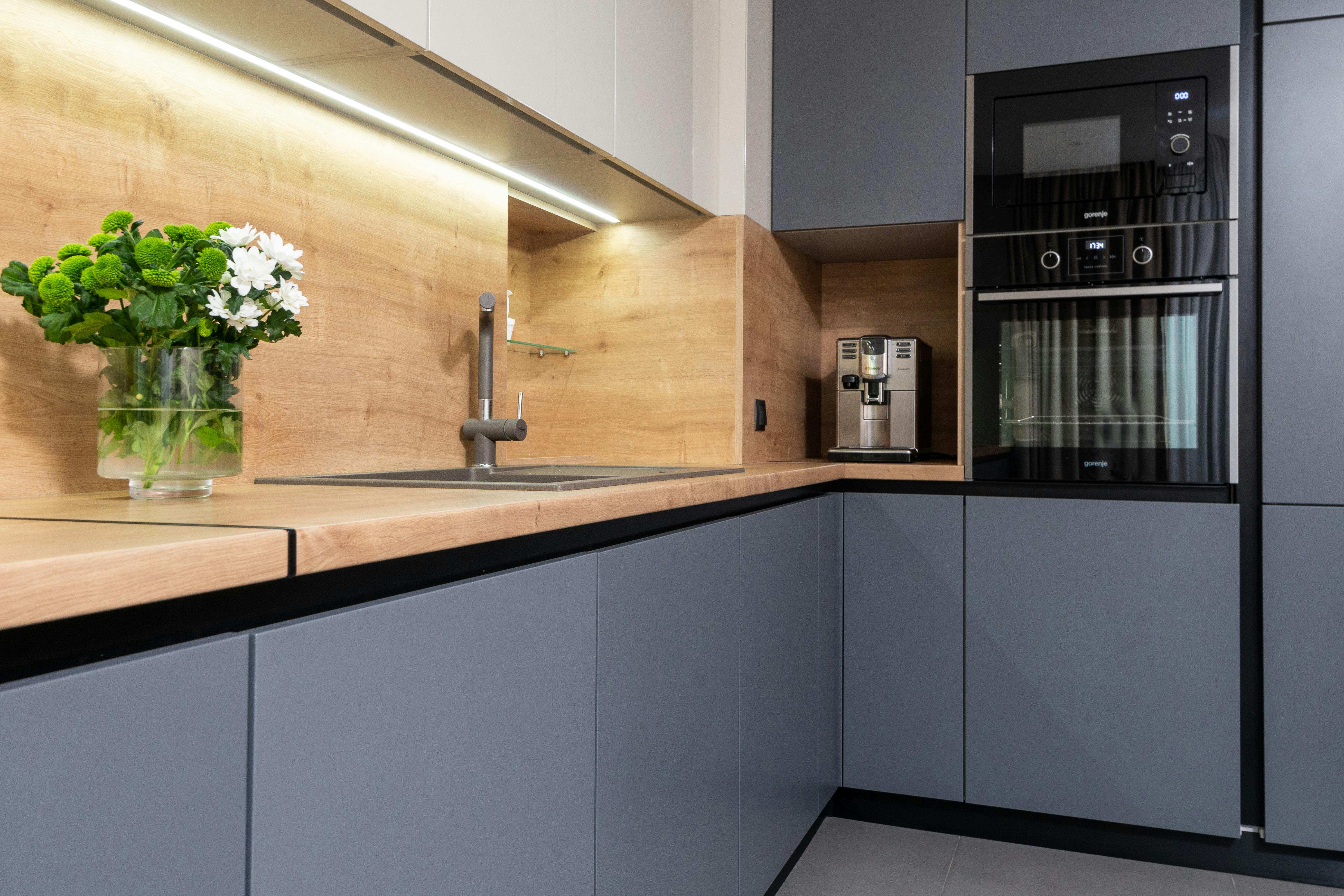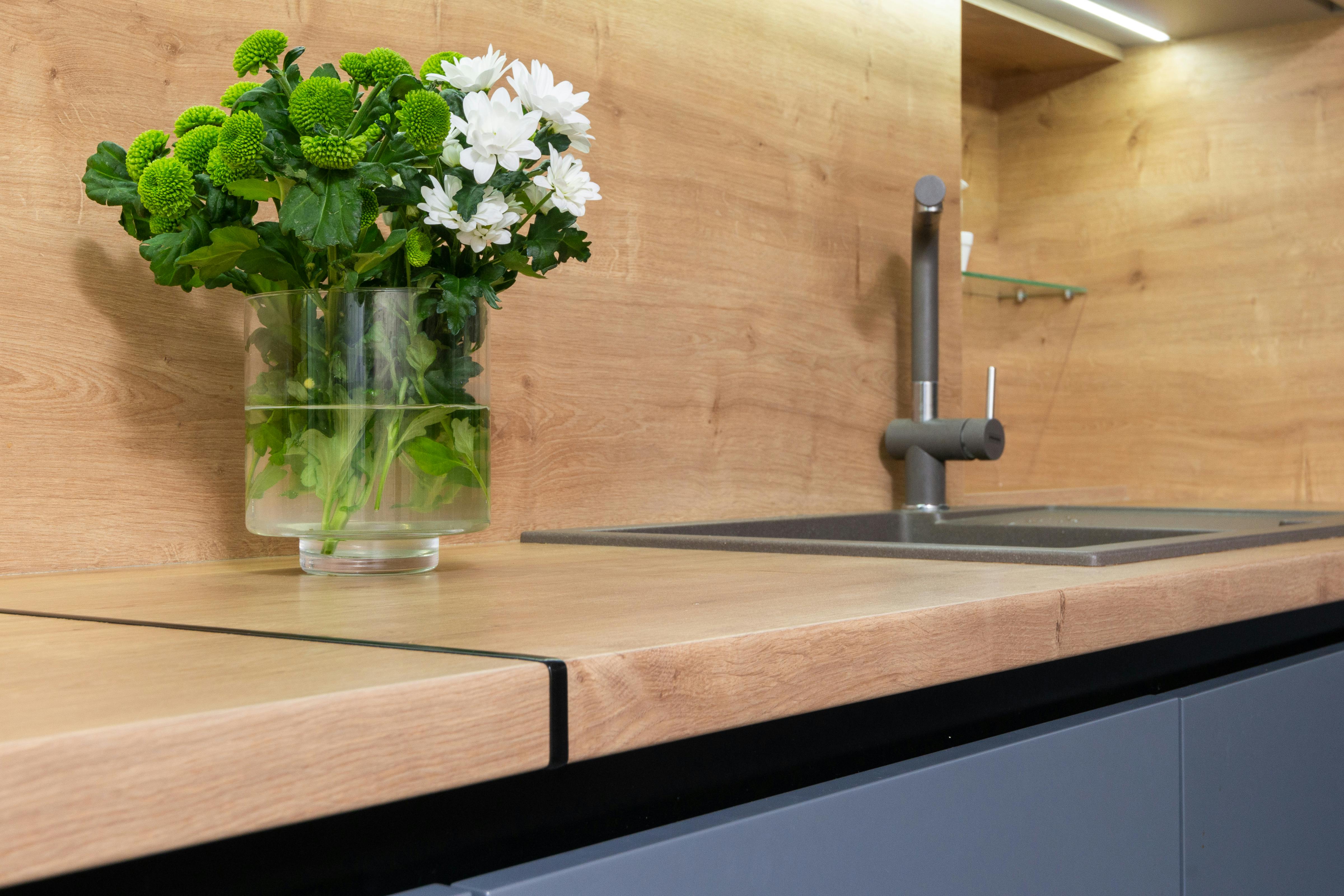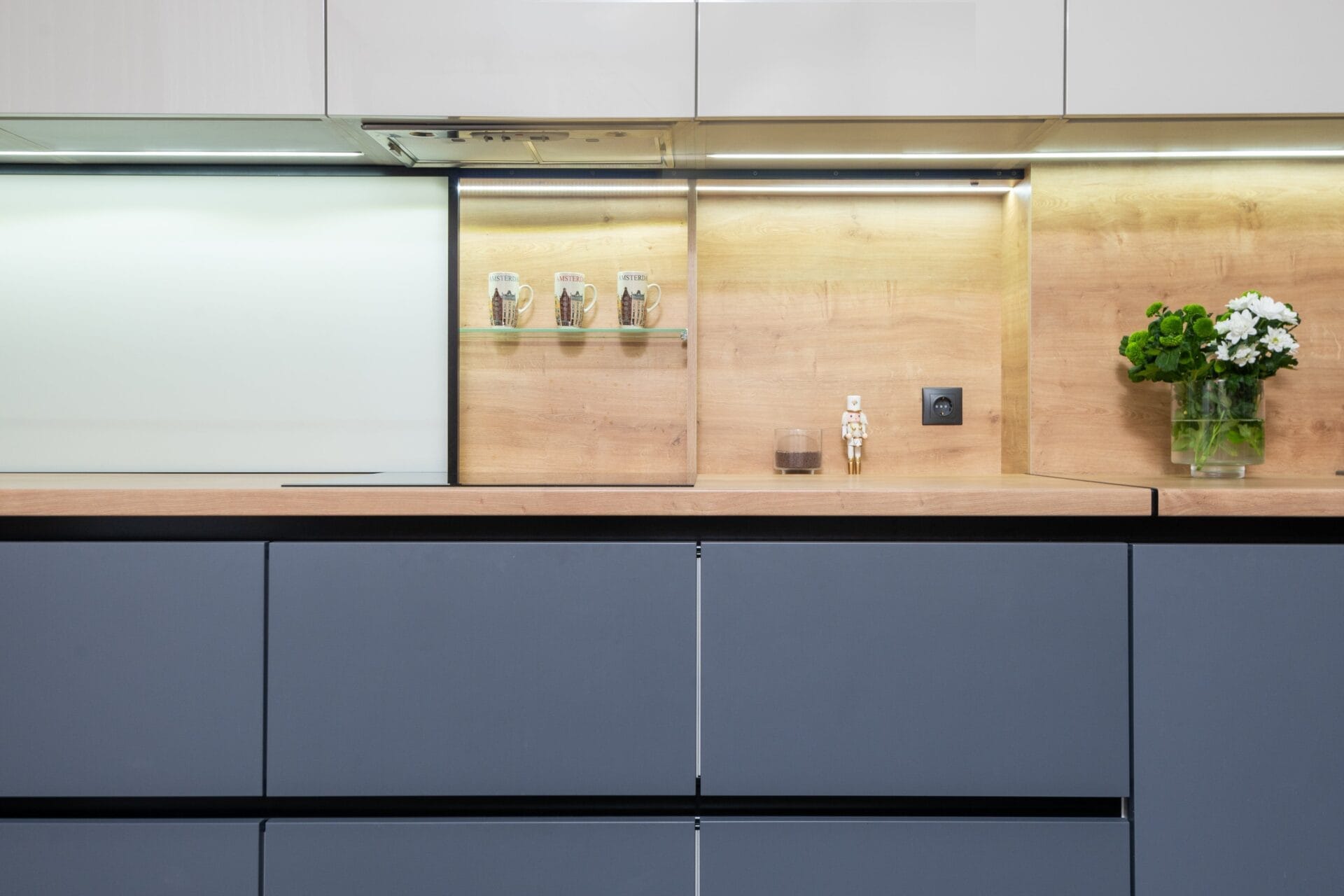If your kitchen cabinets have been damaged by water, you may be wondering how to repair them. Repairing kitchen cabinets with water damage can be a daunting task, but it is possible to restore them and get your kitchen back in shape. In this article, we will discuss the steps required to repair water-damaged kitchen cabinets and provide helpful tips for achieving a successful repair. By following these steps, you can give your kitchen cabinets a fresh start and make them look as good as new.To repair kitchen cabinets with water damage, begin by assessing the extent of the damage. If the damage is minor, try using sandpaper to remove any discoloration and then apply a wood sealer or primer to prevent further damage. For more extensive water damage, it may be necessary to replace the damaged cabinet sections. Start by removing all hardware from the cabinets, such as handles and hinges. Then, cut away any wood that has been damaged beyond repair. Use a chisel or saw to cut out the damaged sections and replace them with new wood pieces cut to fit. After replacing the sections, sand them down and apply a sealant or primer before applying fresh paint or stain. Finally, reattach all hardware and enjoy your newly renovated kitchen cabinets!
Identify the Cause of the Water Damage
Identifying the cause of water damage is essential in order to prevent further damage and restore the affected area. In some cases, identifying the source of water damage may be difficult or impossible to determine. However, there are a few common causes of water damage that may be easier to identify. The most common causes of water damage include leaking pipes, overflowing sinks or toilets, roof leaks, and flooding from heavy rains or storms.
Leaks in pipes can occur due to poor installation or aging pipes. A pipe can also become clogged with debris which causes a backup of water and eventual leaking. Overflowing sinks and toilets can be caused by blocked drains or a malfunctioning valve that doesn’t close properly. Roof leaks can occur due to age, worn out flashing, broken shingles, and improper installation. Flooding can occur due to heavy rains or storms that overwhelm existing drainage systems.
It is important to identify the source of water damage in order to stop it from occurring again in the future. Professional help may be necessary for certain types of water damage as they can involve complex repairs such as replacing pipes or repairing roofs. If you suspect you have a leak or other type of water damage it is best to get it inspected right away before any further damage occurs.
Prepare Your Kitchen Cabinets for Repairs
When it comes to repairing kitchen cabinets, proper preparation is essential for a successful outcome. Before you begin any repairs, it’s important to make sure that your cabinets are clean and free of dust and dirt. This will help ensure that the repair job goes smoothly and that the finished product looks its best. Here are some tips to help you prepare your kitchen cabinets for repairs:
1. Remove any hardware such as hinges, knobs, or pulls from the cabinet doors or drawers. If you’re replacing any of these items, make sure to measure them so that the replacements fit properly.
2. Clean the cabinet surfaces with a mild detergent and water solution. Be sure to rinse off all of the soap residue with a damp cloth.
3. Sand down any rough spots on the cabinet surface using sandpaper or a power sander. Be sure to remove all of the dust particles with a damp cloth before continuing with your repair job.
4. If you plan on painting or staining your cabinets, make sure to apply a primer first in order to provide an even surface for the paint or stain to adhere to.
5. Make sure all of your tools are in good working condition before beginning your project and have plenty of extra supplies on hand in case something goes wrong.
By following these steps, you can ensure that your kitchen cabinets are properly prepared before beginning any repairs or renovations. This will help ensure that the results look their best and last for many years to come!
Repairing Small Areas of Water Damage
Water damage can have a devastating effect on your home or business, causing costly repairs and extensive damage to your property. When water damage is localized to just one area, it can be much easier to repair. Here are some tips for repairing small areas of water damage.
The first step in repairing small areas of water damage is to identify the source of the water. If the water is coming from a broken pipe or a leaking roof, it is important to repair the source before attempting any repairs on the affected area.
Once the source has been identified and repaired, it is important to assess the extent of the damage. The most common signs of water damage in small areas are discoloration, warping or bubbling of drywall or other materials, and staining from mold growth. Depending on the severity of the situation, further steps may be necessary to completely repair the area and restore it to its original condition.
If mold growth has occurred due to the water damage, it should be removed using appropriate cleaning products and techniques. In extreme cases, professional assistance may be necessary for complete removal and remediation of mold growth from an affected area.
Once any visible signs of contamination have been removed, repairs can begin on the affected area. Depending on what materials have been damaged by water, this could involve replacing drywall or flooring, painting walls or ceilings that have been discolored by moisture buildup, or restoring furniture that has been damaged by moisture exposure.
In order to prevent further water damage in these areas it is important to address any underlying issues that caused them in the first place; such as leaks in pipes or roofs that allowed moisture into an enclosed space and allowed mold growth to occur. By making sure all possible sources of moisture are addressed before attempting repairs on an affected area, you can help ensure that future damages are prevented and your property remains safe and protected from further harm caused by water damage.
Replacing Severely Damaged Cabinet Sections
Cabinets are an important part of any home or office. They provide storage and organization for a variety of items. Unfortunately, over time, the cabinets can become severely damaged due to wear and tear. In some cases, the damage can be so severe that it is necessary to replace certain sections of the cabinet. Replacing severely damaged cabinet sections can be a daunting task, but with the right tools and materials, it can be done with relative ease.
The first step in replacing severely damaged cabinet sections is to determine the extent of the damage and decide which sections need to be replaced. In some cases, only one section may need to be replaced while in other cases multiple sections may need to be replaced. Once this has been determined, the next step is to purchase new materials for the replacement sections. This may include plywood, particleboard, or other materials depending on the type of cabinet being replaced.
Once the materials have been purchased, they must be cut and shaped into the appropriate sizes and shapes for the replacement sections. This will require a saw or other cutting tools as well as sandpaper for smoothing out edges and corners. Once all pieces have been cut to size and shape, they must then be assembled into their respective places within the cabinet structure. This will require screws and nails as well as proper measurements for alignment purposes.
Finally, once all pieces have been assembled into place, they must then be painted or stained in order to match existing colors on other parts of the cabinet that are not being replaced. This will ensure that all parts blend together seamlessly once completed. Once this has been done, all that remains is replacing any hardware such as handles or hinges that may have been damaged during disassembly and reassembly of the cabinet structure. With these steps complete, replacing severely damaged cabinet sections should no longer seem like a daunting task but rather an achievable goal with proper planning and execution.

Replacing Damaged Cabinet Hardware
Replacing damaged cabinet hardware can be a simple and straightforward process. All that is typically required is a screwdriver or drill, depending on the type of hardware that needs to be replaced. The first step in replacing damaged cabinet hardware is to remove the old hardware. Unscrew any screws holding the old hardware in place, or use a drill to loosen and remove any bolts. Once the old hardware is removed, inspect the area for any damage to the cabinet itself, such as splitting wood or chipped paint. If there is any damage, it may need to be repaired before installing new hardware.
Next, measure the area where the new cabinet hardware will be installed to ensure an exact fit. Measure from the mounting holes left by the old hardware if possible, and make sure to measure twice before purchasing new hardware. When purchasing new cabinet hardware, make sure it matches in style with other pieces of hardware in your kitchen or bathroom. This will help maintain a consistent look throughout your home.
Finally, install the new cabinet hardware according to instructions provided with it. Make sure that all necessary screws and bolts are tightened securely for maximum strength and stability. Once everything has been installed correctly, check all of the connections one last time to make sure everything is secure and functional before using your cabinets again.
Repainting Your Kitchen Cabinets After Repairs
When it comes to updating the look and feel of your kitchen, one of the most important aspects is making sure that your cabinets are in good condition. If you’ve recently had repairs done on your cabinets, you may want to think about repainting them to make sure they look their best. Repainting your kitchen cabinets after repairs can be a great way to refresh their look and ensure that they are in top condition for years to come.
The first step in repainting your kitchen cabinets is to remove any existing paint from them. This will help ensure that the new paint will adhere properly and provide a smooth finish. You can use a variety of methods, such as sanding or using a chemical stripper, depending on what materials your cabinets are made from. Once all the old paint has been removed, you should give the surface a thorough cleaning with soapy water and a soft cloth.
After the surface is dry, you can start prepping the cabinets for painting. This includes filling any holes or cracks with caulking or spackle and sanding down any rough areas. Once this is done, you can begin applying primer and then two coats of high-quality latex paint in the color of your choice. Make sure to use light coats and allow each layer to dry completely before adding another one.
Once all of the painting steps are complete, it’s time to add any hardware or accessories that you would like on your cabinets. This could include knobs, handles, hinges, or decorative trim pieces. Installing these items will help complete the look and ensure that your newly painted cabinets look their best.
Repainting your kitchen cabinets after repairs is an excellent way to give them an updated look without having to replace them entirely. By taking the time to prepare the surface properly and using high-quality materials for painting, you can enjoy beautiful results that will last for many years to come!
Cleaning and Protecting Your Kitchen Cabinets Post-Repair
When it comes to cleaning and protecting your kitchen cabinets after a repair, there are several things that you need to do. First, you should make sure that all of the surfaces have been properly sanded and cleaned. This is important because if there are any dirt particles left on the surface, they can cause damage over time. Once all of the surfaces have been properly sanded and cleaned, it’s important to apply a protective coating. This will help prevent scratches, dents, and other damage from occurring in the future.
The type of protective coating you use will depend on the type of material your cabinets are made from. For example, if your cabinets are made from wood, then you should use a polyurethane finish or a varnish. If your cabinets are made from metal or plastic then you should use a sealant or a clear coat. Once the protective coating has been applied, you can then start to clean the cabinets with a mild detergent and soft cloth. Make sure to pay special attention to any areas where repairs were made since these areas may be more susceptible to dirt and grime buildup.
Once all of the surfaces have been thoroughly cleaned, it’s important to wax them in order to protect them from future wear and tear. You can use either paste wax or liquid wax depending on what works best for you. When applying wax always be sure to follow the manufacturer’s instructions for best results.
Finally, make sure that all of your cabinet doors and drawers have been properly lubricated so they open and close smoothly without sticking or squeaking. You can purchase specialized lubricants for this purpose or simply use cooking oil in small amounts on door hinges and drawer tracks as needed.
Overall, making sure that your kitchen cabinets are properly cleaned and protected post-repair will help ensure their longevity for years to come!

Conclusion
In conclusion, repairing kitchen cabinets with water damage is possible with the right tools and materials. Be sure to do some research before starting any project and take all safety precautions to ensure that you do not damage the cabinets further. Once the repair is complete, use a sealant to protect the wood and keep it looking like new. Make sure to apply a top coat of paint to finish off the repair for lasting results.
It is important to remember that water damage can occur quickly and if left untreated, can cause serious damage. Taking the time to repair kitchen cabinets with water damage can help prevent more significant damage in the future. Also, it will also add value and beauty to your kitchen space, making it a great investment.
So if you find yourself in a situation where you need to repair kitchen cabinets with water damage, don’t hesitate! With these steps, you can easily restore your cabinets back to their original condition.

